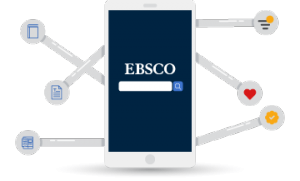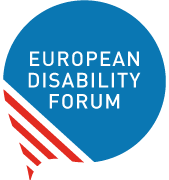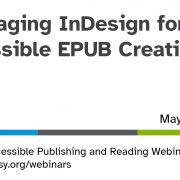EPUB Adoption in Academic Libraries–Progress and Obstacles
 New Inclusive Publishing Partner, EBSCO, explores the challenges of EPUB adoption for academic libraries.
New Inclusive Publishing Partner, EBSCO, explores the challenges of EPUB adoption for academic libraries.
Just as accessibility in publishing has gained momentum in recent years, so has accessibility in libraries. In 2019, the Los Angeles Community College District ruling was an inflection point–libraries were found to bear responsibility for the resources they make available to users, even with limited control over the vendor platforms themselves. Vendors perked up and have made great strides in recent years, ensuring their software and platforms conform to standards whilst providing increasingly accessible experiences for users. Despite the progress with platforms, however, there are still some endemic challenges that limit the accessibility of ebooks in academic libraries. With EBSCO’s scope and reach, we feel we have a vital role to play in addressing these challenges wherever we can.
We see this un-met potential when we look at the EPUB availability and EPUB accessibility of academic content.
One challenge is that the EPUB format has simply not yet achieved broad acceptance with academic users. EPUB has many accessibility advantages compared to PDF, but until the format is pervasive and fully supported, academic users will not fully benefit from those advantages. Since demand for the format is limited, so is the pressure on publishers to create EPUBs and to invest in the accessibility potential. Academic users tend to gravitate to PDF because it’s familiar. They know exactly what they can and can’t do with it, and they’re using PDF for journal articles, which is a large portion of academic research output. EBSCO gives the user a choice to access the EPUB version for every title where the publisher makes both a PDF and an EPUB version available, and users only select the EPUB version 15-20% of the time.
The single biggest factor driving academic libraries’ resistance to EPUB (and the persistence of PDF) is the lack of pagination. Most EPUB files we receive from publishers do not contain pagination, which means there are not stable page numbers for citations, a critical aspect of academic research and scholarly communication. Citation standards have mostly kept up with the times: they instruct users to cite the database or even the chapter and paragraph if an ebook is in EPUB format or is accessed on a reader without stable pagination. This is simply unacceptable for most of the faculty that we talk to, on practical grounds as well as philosophical. Faculty members that have to grade papers and check sources recoil at the thought of finding an ebook in a database and counting paragraphs when they are already sitting under a mountain of undergraduate essays. But perhaps more important is the integrity of knowledge-transfer–it’s important for the scholarly record to easily identify the place in the work where the knowledge was produced, and to preserve the continuity of the scholarly discourse. So “arbitrary” page numbers that might be displayed by the device are not acceptable if they don’t correspond to other versions of the work, and if they aren’t consistent across platforms. Only 25% of our incoming EPUB files contain page numbers, and until we can get this number much higher, academic libraries and users will not adopt EPUB at scale. Without the use and demand, the evolution of the format and the possibilities for academic users that would benefit from it are diminished.
Only 25% of our incoming EPUB files contain page numbers, and until we can get this number much higher, academic libraries and users will not adopt EPUB at scale.
We see this un-met potential when we look at the EPUB availability and EPUB accessibility of “academic content.” Publishers whose content is available in academic libraries range from large commercial publishers to university press publishers (among which there is also much variation), to very small or specialized academic presses. A significant portion of this content set is still in PDF only–30% looking at 2019 and forward publication years. Most of the publishers that aren’t creating EPUB for all of their titles indicate that they can’t afford the EPUB conversion process. It’s an unfortunate reality that many small academic publishers are simply not able to produce EPUB files, let alone born accessible ones. That said, even some major publishers have indicated that if a title has formatting or other characteristics that don’t easily lend themselves to reflow, they only produce a PDF. We are aware of some working groups addressing formatting challenges like these, so we are hopeful that EPUB solutions will be found in the coming years.
Among the EPUB-format files EBSCO receives, not all have been made fully accessible. While the production processes of trade and higher education publishers have matured to the point where most are creating born-accessible EPUB files, the landscape of academic publishers is much more varied. To assess the files we do host, EBSCO created an EPUB assessment tool integrating Ace by DAISY, and to date we have assessed 1.16 million EPUB files. Only around 40% of these fully pass a check for the WCAG 2.1 A standard.
EBSCO works closely with publishers to provide them data about the accessibility of their files. Our detailed “Progress Reports” show them the extent to which they are passing or failing accessibility checks, what percentage of their titles have an EPUB version, and how to access resources, vendors, or organizations like Benetech to help them improve. We even produce a title-level report showing which files pass or fail which WCAG metrics, in the hopes that the data can be used to drive targeted improvements in their production processes. That said, only a quarter of our publishers say that the problem is the know-how. Almost half of publishers say they just don’t have the budget to make the needed improvements to their workflows.
Since EPUB has not yet been broadly adopted (or demanded), few vendors offer online EPUB reading systems which would greatly improve and universalize an accessible experience for users. The reason an online reading system is important is that most academic publishers require the use of (Adobe) DRM to support library checkouts and user access limitations. (Not all publishers require DRM, and for those that don’t, users can get a DRM-free EPUB for download fairly easily.) With the option to access the EPUB online, users can access the full range of EPUB and accessibility features available without having to download into a separate reader that might limit the accessibility of the title.
EBSCO’s choice to offer and evolve a fully-featured online EPUB reader stems from our desire to optimize the experience for all our users, to support the EPUB standard as it evolves, and to be advocates for the potential of EPUB in the academic setting. Each year, we measure our industry’s progress–on EPUB output, on accessibility metrics, and on usage, and we are happy to report that all of these metrics are headed in the direction we, as a community, would like. We have also joined the W3C EPUB working group to address EPUB pagination consistently across the publishing ecosystem. Many of the EPUB working groups are populated by trade publishers and reading system vendors, so we see our role as being advocates for the academic users as a vital partnership with these colleagues. We hope that combining their experience in trade publishing with ours in academic libraries will lead to real benefits for users performing research and accessing readings assigned in academic courses. To learn more about accessibility at EBSCO, visit https://www.ebsco.com/technology/accessibility.
This article was written for Inclusive Publishing by Kara Kroes Li, Director of Product Management, EBSCO






